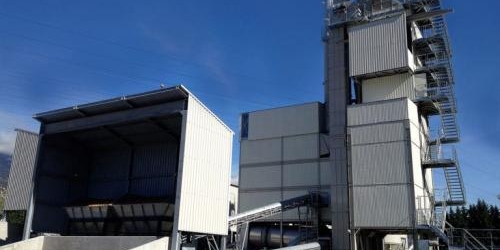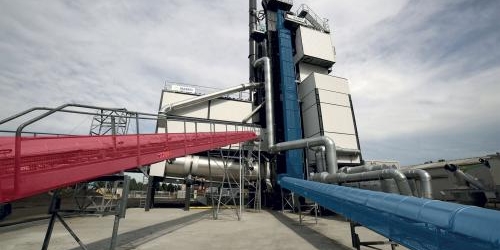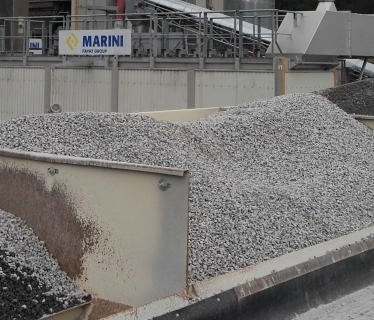
MODERN PROCESS TECHNIQUES FOR THE REUSE OF RECLAIMED ASPHALT PAVEMENT
In many countries there is no legislation limiting RAP employment in the asphalt mix; the choice is often up to the project manager or the contract specifications.
With the appropriate controls, the correct proportions of the ingredients and the employment of adequately equipped plants, it is possible to produce an excellent conglomerate, which in no way falls short of the mixture obtained using only virgin materials. Generally, it is recommended to use high RAP percentages in the lower layers of the pavement (with basic conglomerate or binder), while in the surface layers, which are easily ruined, it is preferable to use very low percentages.
HENCE, USING RAP IMPLIES:
- A preliminary RAP treatment
through a plant devoted to RAP crushing and reselection in different sizes;
- The employment of a specialized and reliable laboratory
in order to study and design the optimal mix;
- The knowledge of the RAP content
in order to identify the type and quantity of the virgin aggregates required to integrate the grading curve;
- The knowledge of the bitumen content in the RAP,
because it is aged and therefore has a lower penetration than the original virgin bitumen. It is also harder because, during the mixing phase in the plant and during its life in the road pavement, it is subject to oxidation processes, which alter its properties. Hence, when employing RAP, the higher viscosity of the older bitumen might also give a certain resistance to mixing. Therefore the properties of the bitumen in an asphalt mix using RAP can be balanced by adding correctly graded virgin bitumen and special rejuvenating additives.
Finally, during the removal phase, it is also very important to carefully position the RAP according to its extraction package and to ensure that it is covered, in order to keep the moisture content as low as possible; this is a determining factor in the employment of RAP. What has been described so far however is not enough on its own. The topic of RAP cannot be considered only in technical terms because nowadays the environment is becoming an an important question. Ultimately, the need arises for constructive and positive collaboration between public authorities, manufacturers and plant operators.
Consequently, the question which has been raised and which requires an environmental, ethical and technical answer becomes the following: on one hand, how can I utilize RAP to obtain a mixture which boasts the same quality as the traditional mix (preserving the bitumen in the RAP and optimizing the percentage used) while, on the other hand, how can I manage the emissions produced by the plant?
APPLICATION TECHNOLOGY
Now we will deal with the most frequent and worldwide spread techniques of RAP employment within the plant , paying particular attention to the aspects concerning the above mentioned friendliness to the environment.
In the production of hot asphalt mix, the mixture has to be heated to a temperature which will ensure satisfactory workability during the laying procedure, and RAP heating must preserve the characteristics of the bitumen and must reduce emissions. It is appropriate to distinguish two ways of heating the RAP, both implemented by different constructors with specific technical solutions.
RAP HEATING THROUGH DIRECT CONTACT WITH THE VIRGIN AGGREGATES
The first case consists of RAP heating through direct contact with the virgin aggregates. The heat from the virgin materials makes the water in the cold RAP evaporate and then the correct temperature in the final mixture can be reached. Among these techniques we can differentiate between either feeding the RAP before the mixing phase or directly during the final mixing phase.

When the RAP is introduced before the mixing phase, this generally means directly into the rotating drying cylinder, which requires equipping the cylinder for introduction of the RAP and providing a special feed line, consisting of a batch hopper plus dedicated transporting belt. For several reasons, it is recommended not to use a screen and consequently it is very important to know the RAP grading. It is possible to use significant RAP percentages, much higher than 30%, after careful selection and preparation of the material. The moisture content inside the RAP is released in the drying cylinder and exhausted through the bag filter. It is well known that the progressive and gradual increase in the bitumen temperature leads to an increase in the amount of released volatile organic compounds. The most recent versions on the market today allow heat transfer which is not damaging for the bitumen contained in the RAP.
The second case permits the use of RAP percentages in the region of 40%, by introducing the RAP directly inside the mixer, a process which means not having to go without a screen. It is necessary for all the moisture content in the RAP and in the virgin aggregates to be eliminated so that the correct temperature in the final mix can be reached and the perfect bitumen coating can be achieved. Therefore, since this physical phenomenon of drying and heating has to occur within the time span of each single mix in the mixer, the virgin aggregates must be heated to a very high temperature. A longer mixing cycle is also often required with consequent reduction in production capacity, which can be balanced out by using a bigger mixer. It is important to manage the water vapour produced in the mixer by eliminating it through the bag filter.
To conclude, a high percentage of cold and humid RAP means a high temperature for the heating of the virgin material as well as an immediate and high production of VOC. Moreover, high temperatures damage both the bitumen in the RAP and the new binder.
For all these reasons, this technique is efficient and useful because it favours the use of very specific fractions in known quantities – before being fed into the mixer the RAP is always weighed However, the maximum limit of usage recommended is below 40% for the reasons mentioned above.

RAP HEATING THROUGH A SPECIAL DEDICATED DRUM
Finally, we will present the second way of heating the RAP, through a special dedicated drum, similar to the one for virgin aggregates. This technique allows the heating of high quantities of RAP to temperatures above 130°C. The reason why this method allows use of percentages even higher than 60-70% is immediately clear. During the final mixing phase it is necessary to integrate the mixture with smaller quantities of virgin materials, which are heated to the extent necessary for reaching the correct final mix temperature required.
The development of this technique was driven by the need to limit high emissions from plants equipped with these systems. In fact, the most recent applications are designed with systems which do not heat up the RAP through the direct exposure to the heat of the flame inside the parallel drying cylinder dedicated only the RAP, but through high volumes of air heated outside the drying cylinder.
In this way, the RAP will gradually reach the temperature of the final mix, and levels as high as 100% may be used. Obviously, the issue is always how to identify in what products it is actually appropriate to employ such a high percentage and such an expensive technology.
Obviously, adequate systems of exhaust, conveyance and treatment of emissions have to be matched with each different RAP usage in the production of hot asphalt mix. In order for these systems to be efficient, the exhaust has to operate in context with the fumes generation, it has to be related to the speed of exhalation and it also has be carried out as close as possible to the emissions points, paying due care to external currents. The emissions are therefore channeled air flow emissions and can be checked before being fed into the stack.
The most appropriate technical solution is closely related to and dependent on the characteristics of the production site, the working methods in operation and the costs/benefits ratio of the technical proposal, plus the ever-important emission “management”.
RAP use in the production of low temperature mixes
Finally, we will briefly examine RAP use in the production of low temperature mixes, with specially equipped plants.
This combination is extremely interesting; for example, the problems related to RAP packing disappear completely with production at low temperatures.
THIS KIND OF PRODUCTION OFFERS MANY ADVANTAGES, WHICH ARE PRIMARILY ENVIRONMENTAL BUT ALSO ECONOMIC:
- Fuel saving when heating virgin aggregates,
which means lower atmospheric emissions as well as lower production costs;
- A more efficient use of bitumen,
with both the new bitumen and the RAP bitumen unaffected by damage created at high temperature, when coming into contact with virgin aggregates;
- Both the VOC and odorous emissions, associated with asphalt mix production, are hugely reduced
if the asphalt mix production occurs at low temperatures, and this can already be seen as soon as temperatures fall by 20 degrees.

